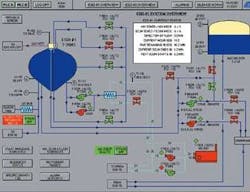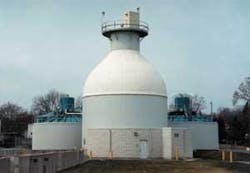By Jack Currie
Recent enhancements incorporated into the original design of the Egg-Shaped Digester (ESD™) anaerobic digester system have led to simplified mechanical systems, which have further improved the life cycle benefits of ESD systems.
Consequently, these improvements have allowed many owners to consider design-build construction of a digester facility. A few of the benefits of this construction approach include single source responsibility, accelerated construction schedule and lower capital cost.
This approach was recently implemented at a facility located in Pinellas County, Florida, USA. The County wanted to build a facility to treat solids that would produce a Class A product in a pelletized form, which could then be marketed and sold. Anaerobic digestion was added to the pelletizing facility to reduce solids, improve product quality and produce gas that could be used in the pelletizing process. Pinellas County negotiated a lump sum, turnkey contract for a 600 m3 ESD facility in the fall of 2000 to meet the start-up schedule.
Design and construction of the facility took place within a 15-month period. Startup and training was completed in the summer of 2002 and turned over to Pinellas County. The overall facility design includes two ESD vessels with the jet pump mixing system, a combination digested sludge gas storage tank and automated system control. The ESD jet pump mixing system replaces the typical mechanical draft tube mixer, providing a more economical approach to the overall design of the facility.
The Pinellas County facility incorporates many recent improvements in ESD technology. Information from the ESD facility control system is communicated throughout the plant. Output screens are transmitted to other operator stations in the facility, which allows a more effective interface between personnel and reduces operator time to monitor the digester operation.
The Pinellas system, depicted on the screen, includes a jet pump mixing system with an internal discharge system that was developed by CB&I, an engineering, procurement and construction company. The jet pump system provides draft tube mixing with no moving internal parts. The internal discharge system is a more cost-effective and reliable method of removing solids from the digester than the external chamber used in early German designs. Utilization of the internal discharge system reduces the potential for the plugging of discharge lines, further reduces the potential for odour emission, maintains the gas tight features of the system and reduces capital cost. All of these benefits further enhance the life cycle costs associated with ESD technology.
ESD technology evolution
One of the most efficient, cost-effective digestion systems for sludge treatment is the ESD anaerobic digester system. The key to the ESD system is the combination of an optimum shaped vessel for process control with an effective liquid mixing to enhance performance. The double curvature shape helps reduce scum, grit build-ups and dead zones, reducing the need to take the digester out of service for cleaning.
Figure 1. Schematic of egg-shaped digester
Dr. Max Pruess of Essen, Germany reported the development of mechanical aides for hastening sludge digestion in 1927. Dr. Pruess's work led to a patent issued in the United States in 1929. By the early 1950s, German engineers recognised the overall benefits offered by an egg-shaped design. These benefits include gas tight vessels with reduced odour emissions, minimal space requirements and lower life cycle operating costs. This process and the vessel developed and used throughout Europe typically included a mechanical draft tube mixing system with an external chamber used to collect material from within the digester and discharge it downstream of the process. This was a huge improvement in comparison to the way sludge treatment was being handled in other parts of the world, including North America.
The ESD technology evolved much slower in North America than in Germany. The City of Los Angeles built the first ESD facility in North America in the late 1970s when they constructed four concrete ESD vessels. In the late 1980s, CB&I introduced the use of steel instead of concrete in building egg-shaped digesters and also improved the treatment process of the facilities (see Figure 1). There are now over 26 ESD facilities constructed of steel either in operation or under construction throughout North America.
Although the first ESD vessels built in North America were constructed of concrete, the predominant material of construction has since been steel. The use of steel has proven to be advantageous in terms of cost and schedule benefits. For instance, building multiple vessels at the same time also allows a more accelerated construction schedule when compared to the forming and pouring of individual concrete vessels. This can be especially valuable when multiple vessels are being constructed within a very small area, as is generally the case when waste treatment facilities are being built in major metropolitan areas.
Figure 3 shows the new ESD facility being constructed at the Newtown Creek wastewater treatment plant (WWTP) in Brooklyn, New York, USA. This facility consists of eight ESD vessels and two storage tanks providing 11,500 m3 of total capacity including digesters and storage. The facility is part of an overall expansion upgrade of the Newtown Creek WWTP solids handling facility to improve the quality of water run off from lower Manhattan. As shown by the picture, conditions are very tight and CB&I has to coordinate logistics for just-in-time deliveries.
ESD technology is widely known as an effective solution for large wastewater treatment facilities, such as the Newtown Creek project, as well as for new digester facilities. Several recent projects using ESD technology have been located in smaller communities with existing anaerobic digestion. One such community is the Town of Midland, Ontario, Canada.
Figure 2. Output screen from Pinellas County ESD control system
The Town of Midland, Ontario is located on Georgian Bay, a large bay on Lake Huron. Midland is well known for its recreation and transportation hub qualities. The area experiences heavy influxes of holiday and weekend tourists during the summer months.
Midland's wastewater treatment plant serves a population of approximately 18,000. The industrial treatment area includes several food processing and light machinery plants. The wastewater treatment plant provides advanced secondary treatment with primary clarification, standard rate activated sludge, and dual point phosphorus removal. A high quality effluent is maintained at all times with discharge to Georgian Bay.
In 1994, a comprehensive plan was developed to upgrade the Midland facility. This upgrade included an expansion of the solids handling facility. The existing facility used heavily overloaded conventional anaerobic digestion; however it was decided to expand the facility by adding a 264 m3 egg-shaped digester as the primary digester with the existing conventional digesters continuing to handle digested sludge and gas storage. Operating since 1996, the upgraded Midland Facility experiences an annual cost savings of more than $60,000 per year.
Conclusion
The evolution of egg-shaped digester technology has been beneficial to communities – large and small – in Europe and North America. For many years, ESD has proven to be an efficient, cost-effective process for reducing the solids prior to their disposal from wastewater facilities. Recent advancements in ESD technology have extended the life cycle and improved the functionality of the facilities, offering effective solutions for communities across the globe.
Jack Currie is the product manager for Biosolids Treatment Systems at CB&I, located in Plainfield, Illinois, USA.





